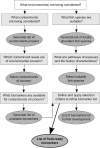A protocol for identifying suitable biomarkers to assess fish health: A systematic review
- PMID: 28403149
- PMCID: PMC5389625
- DOI: 10.1371/journal.pone.0174762
A protocol for identifying suitable biomarkers to assess fish health: A systematic review
Abstract
Background: Biomarkers have been used extensively to provide the connection between external levels of contaminant exposure, internal levels of tissue contamination, and early adverse effects in organisms.
Objectives: To present a three-step protocol for identifying suitable biomarkers to assess fish health in coastal and marine ecosystems, using Gladstone Harbour (Australia) as a case study.
Methods: Prior to applying our protocol, clear working definitions for biomarkers were developed to ensure consistency with the global literature on fish health assessment. First, contaminants of concern were identified based on the presence of point and diffuse sources of pollution and available monitoring data for the ecosystem of interest. Second, suitable fish species were identified using fisheries dependent and independent data, and prioritised based on potential pathways of exposure to the contaminants of concern. Finally, a systematic and critical literature review was conducted on the use of biomarkers to assess the health of fish exposed to the contaminants of concern.
Results/discussion: We present clear working definitions for bioaccumulation markers, biomarkers of exposure, biomarkers of effect and biomarkers of susceptibility. Based on emission and concentration information, seven metals were identified as contaminants of concern for Gladstone Harbour. Twenty out of 232 fish species were abundant enough to be potentially suitable for biomarker studies; five of these were prioritised based on potential pathways of exposure and susceptibility to metals. The literature search on biomarkers yielded 5,035 articles, of which 151met the inclusion criteria. Based on our review, the most suitable biomarkers include bioaccumulation markers, biomarkers of exposure (CYP1A, EROD, SOD, LPOX, HSP, MT, DNA strand breaks, micronuclei, apoptosis), and biomarkers of effect (histopathology, TAG:ST).
Conclusion: Our protocol outlines a clear pathway to identify suitable biomarkers to assess fish health in coastal and marine ecosystems, which can be applied to biomarker studies in aquatic ecosystems around the world.
Conflict of interest statement
Figures



Similar articles
-
Seasonal variation of bioaccumulation in Engraulis encrasicolus (Linneaus, 1758) and related biomarkers of exposure.Ecotoxicol Environ Saf. 2012 Dec;86:31-7. doi: 10.1016/j.ecoenv.2012.09.006. Epub 2012 Sep 25. Ecotoxicol Environ Saf. 2012. PMID: 23020986
-
Fatty acid metabolism in fish species as a biomarker for environmental monitoring.Environ Pollut. 2016 Nov;218:297-312. doi: 10.1016/j.envpol.2016.07.005. Epub 2016 Jul 21. Environ Pollut. 2016. PMID: 27453357 Review.
-
Fish bioaccumulation and biomarkers in environmental risk assessment: a review.Environ Toxicol Pharmacol. 2003 Feb;13(2):57-149. doi: 10.1016/s1382-6689(02)00126-6. Environ Toxicol Pharmacol. 2003. PMID: 21782649
-
Shellfish and residual chemical contaminants: hazards, monitoring, and health risk assessment along French coasts.Rev Environ Contam Toxicol. 2011;213:55-111. doi: 10.1007/978-1-4419-9860-6_3. Rev Environ Contam Toxicol. 2011. PMID: 21541848 Review.
-
An integrated approach in subtropical agro-ecosystems: Active biomonitoring, environmental contaminants, bioaccumulation, and multiple biomarkers in fish.Sci Total Environ. 2019 May 20;666:508-524. doi: 10.1016/j.scitotenv.2019.02.209. Epub 2019 Feb 18. Sci Total Environ. 2019. PMID: 30802666
Cited by
-
Classification of marine microdebris: A review and case study on fish from the Great Barrier Reef, Australia.Sci Rep. 2018 Nov 6;8(1):16422. doi: 10.1038/s41598-018-34590-6. Sci Rep. 2018. PMID: 30401888 Free PMC article. Review.
-
Responses of biomarkers in Atlantic salmon (Salmo salar) following exposure to environmentally relevant concentrations of complex metal mixture (Zn, Cu, Ni, Cr, Pb, Cd). Part II.Ecotoxicology. 2018 Oct;27(8):1069-1086. doi: 10.1007/s10646-018-1960-2. Epub 2018 Jul 10. Ecotoxicology. 2018. PMID: 29987536
-
Minimizing Stress in White Sharks: Non-Invasive Epidermal Biopsies for Isotopic and Vitellogenin Analyses.Biology (Basel). 2025 Feb 13;14(2):192. doi: 10.3390/biology14020192. Biology (Basel). 2025. PMID: 40001960 Free PMC article.
-
The effects of tissue fixation on sequencing and transcript abundance of nucleic acids from microdissected liver samples of smallmouth bass (Micropterus dolomieu).PLoS One. 2020 Aug 10;15(8):e0236104. doi: 10.1371/journal.pone.0236104. eCollection 2020. PLoS One. 2020. PMID: 32776939 Free PMC article.
-
Discovery of mass spectral peak markers and protein biomarkers in fish muscle exudates for rapid and precise recognition of fish species via magnetic beads (MBs) and mass spectrometry.Food Chem X. 2024 May 28;22:101509. doi: 10.1016/j.fochx.2024.101509. eCollection 2024 Jun 30. Food Chem X. 2024. PMID: 38883916 Free PMC article.
References
-
- Joint Group of Experts on Scientific Aspects of Marine Environmental Protection. Protecting the oceans from land-based activities—Land-based sources and activities affecting the quality and uses of the marine, coastal and associated freshwater environment. 2001. Available from: http://www.gesamp.org/publications/publicationdisplaypages/rs71.
-
- Granek EF, Polasky S, Kappel CV, Reed DJ, Stoms DM, Koch EW, et al. Ecosystem services as a common language for coastal ecosystem-based management. Conserv Biol. 2010; 24: 207–16. doi: 10.1111/j.1523-1739.2009.01355.x - DOI - PubMed
-
- Adams SM. Assessing cause and effect of multiple stressors on marine systems. Mar Pollut Bull. 2005; 51: 649–57. doi: 10.1016/j.marpolbul.2004.11.040 - DOI - PubMed
-
- van der Oost R, Beyer J, Vermeulen NPE. Fish bioaccumulation and biomarkers in environmental risk assessment: a review. Environ Toxicol Pharmacol. 2003; 13: 57–149. - PubMed
MeSH terms
Substances
LinkOut - more resources
Full Text Sources
Other Literature Sources

